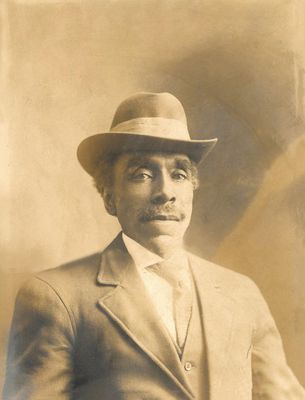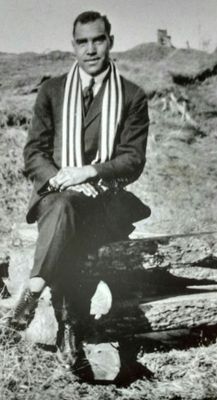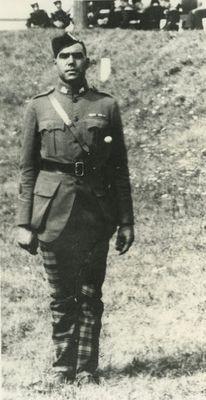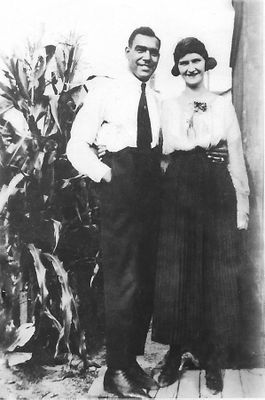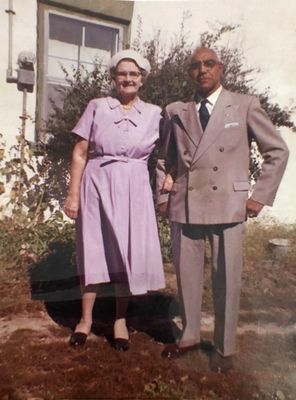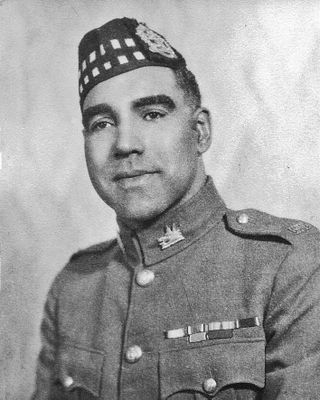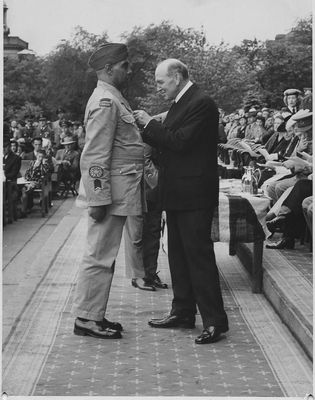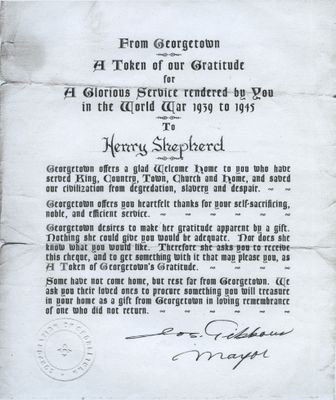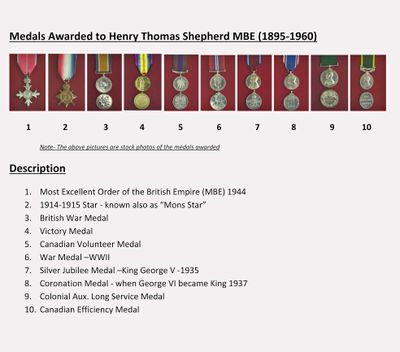Henry Thomas Shepherd
Henry’s story begins in the 1850’s when his grandmother (known only as Mrs. Shepherd) escaped slavery and fled to Canada with her infant son, John Henry (Henry’s father) via the Underground Railroad.
Mrs. Shepherd and John Henry were welcomed on a local Stewarttown farm owned by Colonel John Murray. Living in a small cabin in Georgetown Park, Mrs. Shepherd and John walked daily to the Murray farm in Stewarttown where she worked as a housekeeper up until her passing sometime before 1871. After her death, young John was taken to live on the farm where he was raised by Colonel John Murray and his family and worked as a farmhand.
Sarah Hartley was a 16-year-old British Home Child sent to Canada in 1886 and assigned to the Murray farm as an indentured servant. John Shepherd and Sarah Hartley were married at St. George’s Anglican Church in Georgetown in December 1887. John and Sarah would go on to have six children; Violet, Jessie, Flora, Johnetta, Henry and John.
Henry Thomas Shepherd was born August 18, 1895. He was the second youngest of six children. Henry attended public school in Stewarttown and Georgetown.
Henry worked on the area farms and delivered mail between Stewarttown and Ashgrove. He also drove Willoughby's Union Bus delivering passengers to and from the Grand Trunk Station in Georgetown.
Following his father, Henry worked at the Coated Paper Mill (later known as Domtar Fine Papers Ltd.) where he remained for 45 years while also serving in the Army militia and Canadian Army during WWI and WWII.
In 1911, Henry began his military service when he joined the Halton Rifles.
In 1915, at the declaration of WWI, Henry enlisted in Niagara with the 2nd Battalion – Canadian Expeditionary Forces. Henry was sent to England where he was transferred to the 58th Battalion upon arrival. He served with the 58th in France and Belgium, was wounded twice and returned to duty both times. Henry was one of the very few Black soldiers who served in a non-segregated battalion during WWI. For his service, Henry was awarded the 1914 Star (Mons Star), the British War Medal and the Victory Medal.
At the outbreak of WWII, Henry re-enlisted as a Private in 1939 however due to his injuries from WWI, he was not eligible for overseas service. With his extensive military experience, Henry trained at the University Armouries in Toronto before transferring to Newmarket #23 Training Centre where he was promoted to Company Sergeant Major (CSM). After the training camp closed in 1943, Henry was made Deputy Fire Marshall for all military camps in Ontario and stationed in Monteith, at a Prisoner of War Camp near Iroquois Falls, Ontario.
After WWI, Henry came home and returned to his job at the paper mill. He married Susanne Maude Cox in 1923 at St. George’s Anglican Church in Georgetown and they went on to have eight children, Helen, Doris, June, Violet, Mabel, John, Lillian and Jacqueline. John unfortunately passed away at a young age.
In his civilian life, Henry served as a longstanding volunteer firefighter and in 1938 he was appointed Chief of the Georgetown Fire Department, the first Black man to hold the position.
In 1928, Henry was one of the founding members of the Georgetown Branch #120 Legion and stayed active in the military with the Halton Rifles. He was promoted and became Regimental Sergeant Major (RSM) with the Lorne Rifles and the Lorne Scots (1935-1939), making him the first Black man to earn the title in Canada according to their records.
Henry maintained his connection with the Lorne Scots and proudly marched as Parade Marshal for many years.
In 1935, Henry received the King George V Silver Jubilee Medal and when George VI became King in 1937, Henry also received the Coronation Medal.
For his service during WWII, he was awarded the Canadian Volunteer Medal, the War Medal, the Colonial Auxiliary Forces Long Service Medal and the Canadian Efficiency Medal. In 1944, Henry was named on the King’s Birthday Honour List and was appointed to the Most Excellent Order of the British Empire (MBE) for valour. Henry was highly respected within the military by his officers and fellow soldiers and remained an active member of his community until his passing on July 24, 1960, at Sunnybrook Hospital in Toronto. Henry is buried in Greenwood Cemetery in Georgetown.
In the years after his death, Henry has continued to receive recognition for his community and military service and has been acknowledged in several history books, publications and newspaper articles. For Remembrance Day 2016, Henry’s life story was featured on a CBC Television special and in that same year, he was also featured in Kathy Grant’s exhibit of Black soldiers at the National War Museum in Ottawa. The Legion in Newmarket has a prominent tribute to his service as CSM of the Newmarket Training Camp. In 2018, the Shepherd family was also featured at the Old Town Hall exhibit for their first Black History Month.
Mrs. Shepherd and John Henry were welcomed on a local Stewarttown farm owned by Colonel John Murray. Living in a small cabin in Georgetown Park, Mrs. Shepherd and John walked daily to the Murray farm in Stewarttown where she worked as a housekeeper up until her passing sometime before 1871. After her death, young John was taken to live on the farm where he was raised by Colonel John Murray and his family and worked as a farmhand.
Sarah Hartley was a 16-year-old British Home Child sent to Canada in 1886 and assigned to the Murray farm as an indentured servant. John Shepherd and Sarah Hartley were married at St. George’s Anglican Church in Georgetown in December 1887. John and Sarah would go on to have six children; Violet, Jessie, Flora, Johnetta, Henry and John.
Henry Thomas Shepherd was born August 18, 1895. He was the second youngest of six children. Henry attended public school in Stewarttown and Georgetown.
Henry worked on the area farms and delivered mail between Stewarttown and Ashgrove. He also drove Willoughby's Union Bus delivering passengers to and from the Grand Trunk Station in Georgetown.
Following his father, Henry worked at the Coated Paper Mill (later known as Domtar Fine Papers Ltd.) where he remained for 45 years while also serving in the Army militia and Canadian Army during WWI and WWII.
In 1911, Henry began his military service when he joined the Halton Rifles.
In 1915, at the declaration of WWI, Henry enlisted in Niagara with the 2nd Battalion – Canadian Expeditionary Forces. Henry was sent to England where he was transferred to the 58th Battalion upon arrival. He served with the 58th in France and Belgium, was wounded twice and returned to duty both times. Henry was one of the very few Black soldiers who served in a non-segregated battalion during WWI. For his service, Henry was awarded the 1914 Star (Mons Star), the British War Medal and the Victory Medal.
At the outbreak of WWII, Henry re-enlisted as a Private in 1939 however due to his injuries from WWI, he was not eligible for overseas service. With his extensive military experience, Henry trained at the University Armouries in Toronto before transferring to Newmarket #23 Training Centre where he was promoted to Company Sergeant Major (CSM). After the training camp closed in 1943, Henry was made Deputy Fire Marshall for all military camps in Ontario and stationed in Monteith, at a Prisoner of War Camp near Iroquois Falls, Ontario.
After WWI, Henry came home and returned to his job at the paper mill. He married Susanne Maude Cox in 1923 at St. George’s Anglican Church in Georgetown and they went on to have eight children, Helen, Doris, June, Violet, Mabel, John, Lillian and Jacqueline. John unfortunately passed away at a young age.
In his civilian life, Henry served as a longstanding volunteer firefighter and in 1938 he was appointed Chief of the Georgetown Fire Department, the first Black man to hold the position.
In 1928, Henry was one of the founding members of the Georgetown Branch #120 Legion and stayed active in the military with the Halton Rifles. He was promoted and became Regimental Sergeant Major (RSM) with the Lorne Rifles and the Lorne Scots (1935-1939), making him the first Black man to earn the title in Canada according to their records.
Henry maintained his connection with the Lorne Scots and proudly marched as Parade Marshal for many years.
In 1935, Henry received the King George V Silver Jubilee Medal and when George VI became King in 1937, Henry also received the Coronation Medal.
For his service during WWII, he was awarded the Canadian Volunteer Medal, the War Medal, the Colonial Auxiliary Forces Long Service Medal and the Canadian Efficiency Medal. In 1944, Henry was named on the King’s Birthday Honour List and was appointed to the Most Excellent Order of the British Empire (MBE) for valour. Henry was highly respected within the military by his officers and fellow soldiers and remained an active member of his community until his passing on July 24, 1960, at Sunnybrook Hospital in Toronto. Henry is buried in Greenwood Cemetery in Georgetown.
In the years after his death, Henry has continued to receive recognition for his community and military service and has been acknowledged in several history books, publications and newspaper articles. For Remembrance Day 2016, Henry’s life story was featured on a CBC Television special and in that same year, he was also featured in Kathy Grant’s exhibit of Black soldiers at the National War Museum in Ottawa. The Legion in Newmarket has a prominent tribute to his service as CSM of the Newmarket Training Camp. In 2018, the Shepherd family was also featured at the Old Town Hall exhibit for their first Black History Month.
